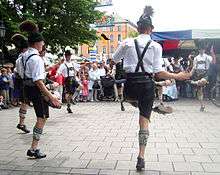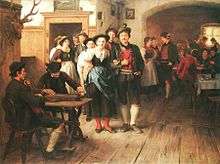Schuhplattler
The Schuhplattler is a traditional style of folk dance popular in the regions of Bavaria and Tyrol (southern Germany, Austria and the German-speaking regions of northern Italy). In this dance, the performers stomp, clap and strike the soles of their shoes (Schuhe), thighs and knees with their hands held flat (platt). There are more than 150 basic Schuhplattlers, as well as marches and acrobatic feats that are often interspersed with the basic dance in performance. They may be seen today in Europe and in German immigrant communities around the world. While the Schuhplattler is still largely performed by adults, it has become increasingly popular with youngsters, who love its colorful costumes and its bouncing, leaping, kicking and choreographed horseplay.[1]
 Schuhplattler group in Munich | |
| Genre | Social dance, folk dance |
|---|---|
| Time signature | 3 4 |
| Origin | Bavaria and Tyrol |
History and style

The Schuhplattler is thought to date from Neolithic times, about 3000 BC,[2] but it is first of record in 1030 AD, when a monk in the Tegernsee Abbey of Bavaria described a village dance containing leaps and hand gestures.[3] Over the centuries, the form gradually evolved as farmers, hunters, and woodsmen practiced it in the isolated towns and villages of the Bavarian and Tyrolean Alps.[4] Sometimes it was performed as a partner dance, with couples doing a Ländler and then splitting up so the girls could twirl in their colorful dirndls as the boys showed off their platteln. At other times it was just the boys onstage, arranged in a circle, a square or a line, plattling wildly for the audience. These two approaches are sometimes distinguished as the Schuhplattlertanz and Schuhplattler proper, but it is the "boys' dance" that is at the core of both forms and is most often described.[5]
The immediate precursors of today's Schuhplatter were the 18th century Minuet, Quadrille and Française, but unlike these courtly and highly stylized dances, the early plattlers of the common folk were free of rules. The young men improvised their leaps, stomps, and acrobatic figures "as it struck their fancy."[6] Acrobatics were an important part of the dance at least by the 1820s, when boys began balancing on the shoulders of their partners and stamping their feet rhythmically on the ceiling![7]
Early Schuhplattlers often highlighted the towns where they were invented or imitated the various professions of the performers, such as the Mühlradl (miller's dance), the Holzhacker (wood cutter), and the Glockenplattler (bell dance). The music was generally in three-quarter time, like the Ländler, and was performed on the zither or the guitar, and by 1830s, the accordion or concertina.
In 1838, the Empress of Russia was honored with a Schuhplattler by the residents of the bath town of Wildbad Kreuth,[8] and the aristocracy, fascinated by the strange costumes and quaint pursuits of the common folk, began taking an interest in the dance. Many consider the real birth of the modern Schuhplattler, however, to be King Maximilian II of Bavaria's excursion through the Alps in 1858, when locals performed the dance for him, and he fell in love with it.[9]
In 1886 the French traveler Hugues Krafft wrote of the Schuhplattler:
- On Sundays and holidays one sees couples dancing to music on larger town squares everywhere — preferably the Ländler, a leisurely waltz popular among girls and boys. The biggest attraction, however, even for the local farmers, is always the Schuhplatter. It ... begins with forming a circle. Then, while the girl is briefly separated from her partner and continues to follow waltz steps, the boy must perform a number of difficult movements to the beat of the music. He turns around on his axis, slaps his thighs and legs, falls to his knees, jumps in the air and throws his hat as he lets out a joyful whoop... Those who master the dance are cheered with vigorous applause.[10]
By the late 19th century, traditional costume clubs (Trachtenvereine) were being established throughout Bavaria and Tyrol, and soon these groups spread to German communities in America and elsewhere. Since the mission of these clubs was to preserve the age-old customs, lore and dress of the German and Austrian Alps, the Schuhplattler became a central part of their programs. The Trachtenvereine were often strict and exacting about how the dance was to be performed and how club members were to dress, although new Schuhplattler groups sprang up after the second world war that were less tied to the older forms.
Costume

For the Schuhplattler, lederhosen and dirndls are a must. These range from the simple, practical styles that have been worn in Bavaria and Tyrol for generations to the finest ornate varieties that can cost a thousand dollars or more. Kniebund Lederhosen (knickers) are worn by some Schuhplatter groups, but they can be uncomfortable to dance in,[11] especially in warm weather. More common are short lederhosen, which range from the knee-length version favored by traditionalist groups and Munich Oktoberfest visitors to the much shorter variety worn in South Tyrol. While European scouts have always worn lederhosen without suspenders, costume and dance groups wear either standard narrow H-bar suspenders or the wider, heavily embroidered, fancy-dress variety. Socks are knee length in solid gray, green or white. Loferl-style socks are ankle-length and have a separate band that goes around the calf.
The dirndl emerged during the 18th century as a plain, practical servant's dress with a long skirt, bodice, blouse and apron. In the wintertime it was made of heavy cotton, linen or wool with long sleeves, and in summer it was short-sleeved and of lighter material. In the second half of the 19th century, as the Schuhplattler and lederhosen became fashionable amongst the nobility, dirndls evolved into stylish attire made of silk or satin for the very rich. Their popularity has risen and fallen over the years, but like lederhosen, the dirndl has lately had something of a resurgence in Germany and Austria.
The Schuhplattler today
Traditionalist Trachtenvereine around the world still perform the Schuhplattler as a partner dance, with the women spinning across the stage in their dirndls, offering color and graceful movement to counterbalance the leaping and slapping of the plattlerists. The newer dance groups, on the other hand, are often composed entirely of plattlerists. They, too, perform the standard Schuhplattlers, but they do so with a contemporary energy and excitement that draws in the crowds.
Among these contemporary groups are some top-notch children's clubs like the Oberbairing Kinder and the Jungen Wimberger, that are often associated with adult clubs but perform in festivals and competitions on their own. Like their adult counterparts, they dance not only with precision but also with a zest and enthusiasm that can leave audiences cheering. In watching these youngsters perform, one has the sense that the Schuhplattler is not only tradition, culture and skill, but can also be packed with energy, laughter and fun.
Winged word
Russian folk dance
A similar dance technique exists in the Russian folk dance, only that in Russian dance the male dancers stomp, clap and strike in addition to sole, front of the foot, thighs, knees also the chest. It is made at a faster pace in Russian folk dance.[13][14]
See also
- Austrian folk dancing
- Music of Austria
- Tracht
References
- Webpage: Schuhplattler Kids, www.schuhplattlerkids.org, created June 27, 2014
- Homer, Trevor. Book of Origins, Penguin Books, 2007.
- Hegenbarth, Franz. Auf Geht's: Das Buch übers Scuhplatteln, Verlagsanstalt Bayerland, 1990, p. 25.
- Hegenbarth, p. 13.
- Hegenbarth, pp. 14, 68-74. See also Richard Wolfram, Die Volkstänze und Verwandte Tänze in Europa, O. Muller, 1951, p. 190; and Gerhard Maier, Miesbach – Wiege der Trachtenbewegung, Verlag Miesbacher, 1976.
- Lipowsky, Felix Joseph. Sammlung Bayerischer National-Costüme. Hermann & Barth, 1820.
- Jahrbuch des Österreichischen Volksliedwerkes, vol. 56, 2007, p. 103.
- Hegenbarth, p. 49.
- Hegenbarth, pp. 51, 71, 75-76.
- Spangenberg, Marcus, and Sacha Wiedenmann (Hrsg.) 1886. Bayern und die Schlösser König Ludwigs II. aus der Sicht von Hugues Krafft / 1886, Verlag Schnell und Steiner, Regensburg 2011, p. 48.
- Hegenbarth, p. 23.
- Die Zeit, No. 47, 1971
- Smorodinskaya (2012). Encyclopaedia of Contemporary Russian. Routledge. p. 215. ISBN 1283882922. OCLC 843080802.
- WeiT Media (2017-04-30), 'Танцуют все!'. Русский народный танец. 'The First Crew', retrieved 2019-03-09
Further reading
- Franz Hegenbart: Auf geht's, das Buch übers Schuhplatteln, Dachau 1990. ISBN 3-89251-078-4
- Schuhplattler aus Tirol: Gesammelt von Karl Horak. - Innsbruck: Tiroler Volksliedwerk, 1980.
External links
| Wikimedia Commons has media related to Schuhplattler. |
- Bayerischer Heimat- und Trachtenverein "Golden Gate" (English)
- Schuhplattler Kids (English & German)
- Schuhplatter Kids Facebook
- Gauverband1 (German)
- Gauverband Nord Amerika (English)
- Geschichte des Schuhplattlers (German)
- GTEV Schlierachtaler Stamm (English)
- Holzhacker Plattler – Tegernsee (German)
- Pichler Voigasplattler (German)
- Schuhplattler Verein Heidengold (English)
- Schuhplattlergruppe Kohlrösl-Buam Gitschtal (German)
- Schuhplattlergruppe Tramin – Südtirol (German)
- The Gemuetlichen Schuhplattler of Anaheim, California (English)
- The Edmonton Schuhplattler Dancers - Canada (English)
- Texanischer Schuhplattler Verein D'Holzar - Dallas, Texas (English)